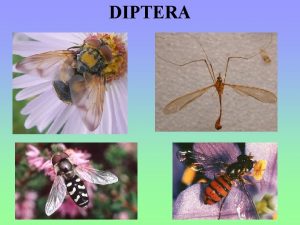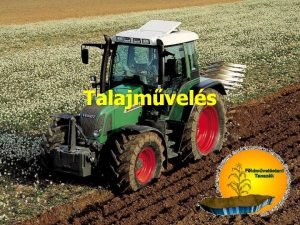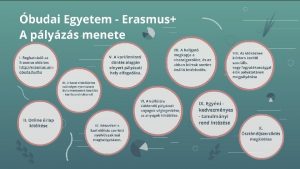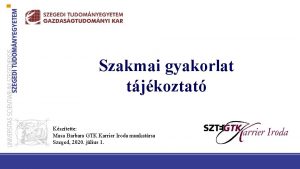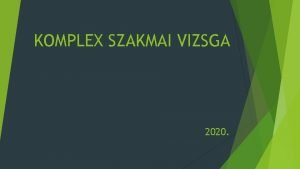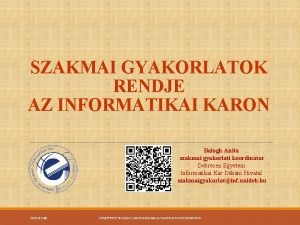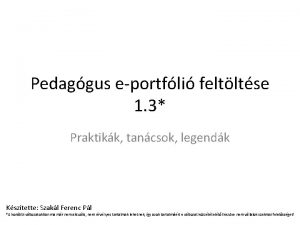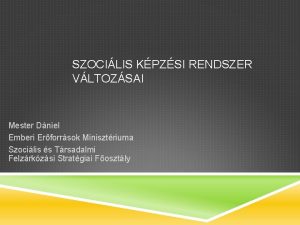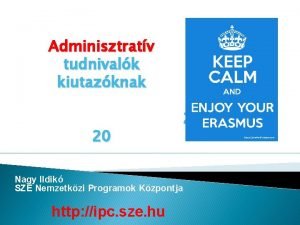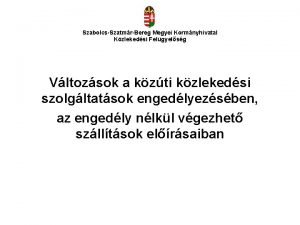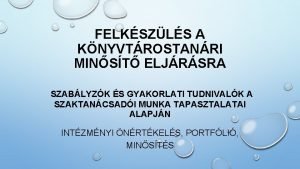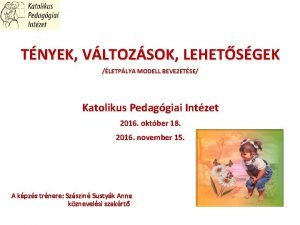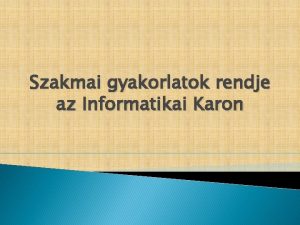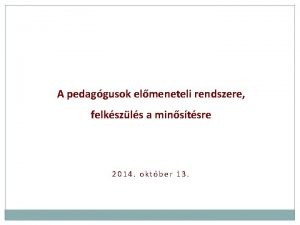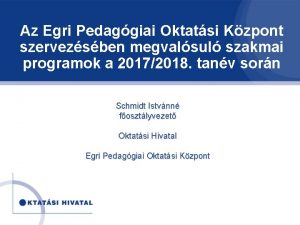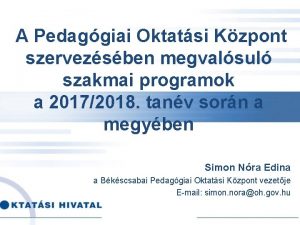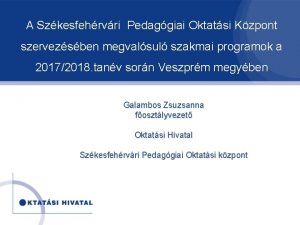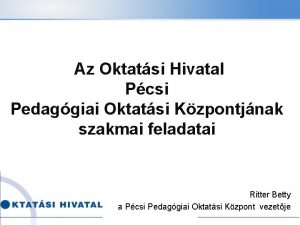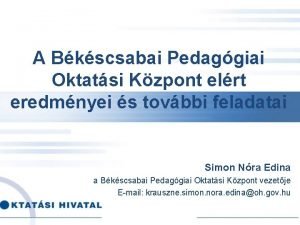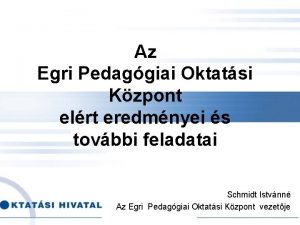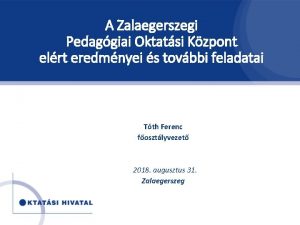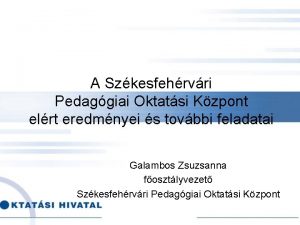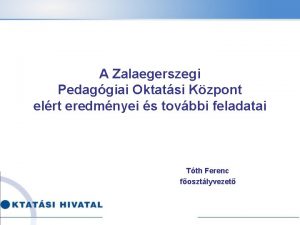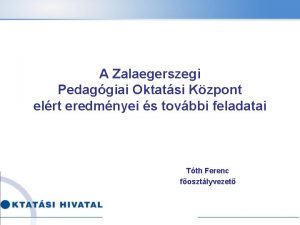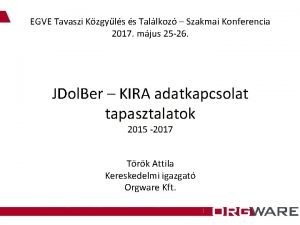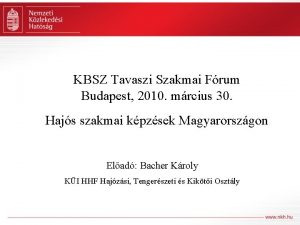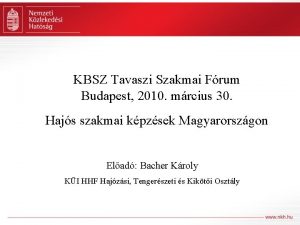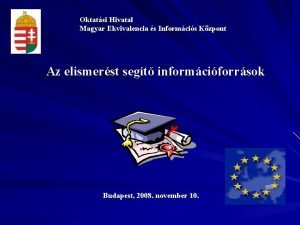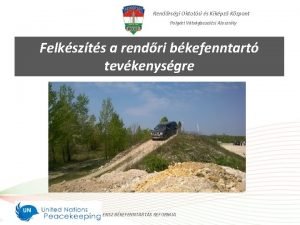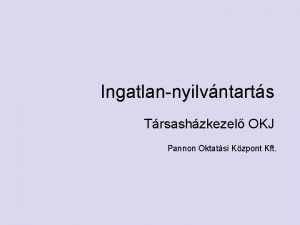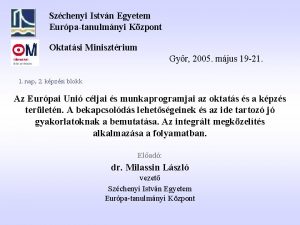Szegedi Pedaggiai Oktatsi Kzpont Tavaszi Pedaggiai Szakmai Napok


















































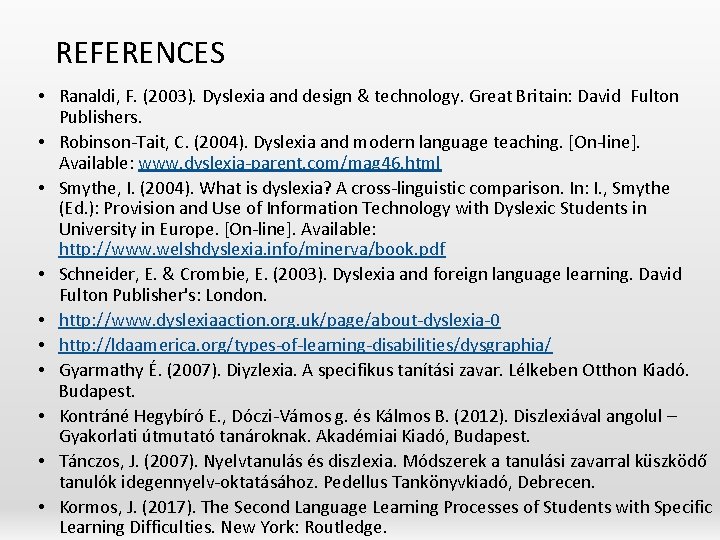

- Slides: 52

Szegedi Pedagógiai Oktatási Központ Tavaszi Pedagógiai Szakmai Napok 2017. április 19 -28. Teaching vocabulary to students with dyslexia Diszlexiás tanulók idegen nyelvi szókincsének fejlesztési lehetőségei Andrea Magyar

Please, brainstorm 1. Define the notion of Dyslexia! (Learning difficulties or learning differences? ) 2. What characterizes learners with dyslexia, dysgraphia? 3. What are the difficulties caused by dyslexia in learning a foreign language? 4. Discuss your personal experiences! Judit Kormos: Dyslexic learners Time limit: 5 min.

Dyslexia: Definition and Symptoms Dyslexia is a specific learning difficulty that primarily affects the ability to learn, to read and spell. • It involves difficulties in dealing with the sounds of words, which makes it especially hard to learn to use phonics to read words. • It can affect short-term memory and speed of recalling names. • Other kinds of difficulties, for example with maths or with coordination, sometimes go alongside dyslexia, but they do not always. http: //www. dyslexiaaction. org. uk/page/about-dyslexia-0

Dysgraphia: Definition and Symptoms Affects a person’s handwriting ability and fine motor skills. • A person with this specific learning disability may have problems including illegible handwriting (e. g. irregular sizes, shapes or slant of letters, unfinished words or letters, omitted words), • inconsistent spacing between words and letters, • poor spatial planning on paper, • poor spelling, and • difficulty composing writing as well as thinking and writing at the same time (taking notes, creative writing). http: //ldaamerica. org/types-of-learning-disabilities/dysgraphia/

Common misbeliefs about dylexia • Writing letters and words backwards are symptoms of dyslexia. • Reading disabilities are caused by visual perception problems. • If you just give them enough time, children will outgrow dyslexia. • More boys than girls have dyslexia. • Dyslexia only affects people who speak English. • A person with dyslexia can never learn to read. 5

SPELLING PROBLEMS • Deep orthography: they misspell words: selary-salary, stady-study, sinse-since • They reverse the order of letters thier- their, Ducth-Dutch • Insertion and omission of certain letters: slowly-slowely , pav(e)ment, tought-thought • Confuse similar words Visual similarity: waist-wrist, water- waiter-weather, quit- quiet-quite, week-weak Seen at a pizza shop: 7 days without pizza makes one weak. Semantic similarity: (the pronunciation is the same but the spelling and meaning are different). Let’s talk about rights and lefts. You’re right, so I left.

Semantic matters, morphological humor What did therabbit give his girlfriend? --A 24 carrot ring What kind of animal comes out only on cloudy days? —A reindeer What two letters of the Alphabet contain nothing? --M. T 7

Experimental learning task The aim of this activity is for you to experience how it feels to have to perform a task when you are disadvantaged physically by using your weaker writing hand, and challenged cognitively by having to make changes to a text as you copy it. It is interesting to notice the different strategies that people employ when under pressure. Please follow the instructions! 8

Unit 2 Task 1: experiential activity

Unit 2 Task 1 Read the instructions and then copy the text. Project N° 2014 -1 -PL 01 -KA 200 -003578 This project has been funded with support from the European Commission.

INSTRUCTIONS • Pick up some paper and a pen or pencil. Project N° 2014 -1 -PL 01 -KA 200 -003578 This project has been funded with support from the European Commission.

INSTRUCTIONS • Pick up some paper and a pen or pencil. • If the paper has lines, turn it round so it is landscape. • If the paper has no lines, turn it so it is portrait. Project N° 2014 -1 -PL 01 -KA 200 -003578 This project has been funded with support from the European Commission.

INSTRUCTIONS • Pick up some paper and a pen or pencil. • If the paper has lines, turn it round so it is landscape. • If the paper has no lines, turn it so it is portrait. • Pick up your pen or pencil in the hand that you don’t normally write with. Project N° 2014 -1 -PL 01 -KA 200 -003578 This project has been funded with support from the European Commission.

INSTRUCTIONS • Pick up some paper and a pen or pencil. • If the paper has lines, turn it round so it is landscape. • If the paper has no lines, turn it so it is portrait. • Pick up your pen or pencil in the hand that you don’t normally write with. • If you are writing with a black pen stand up. • If you are using a pencil, push your sleeves up. Project N° 2014 -1 -PL 01 -KA 200 -003578 This project has been funded with support from the European Commission.

Now you are going to see a short text, and you will have 3 minutes to copy it down. BUT whenever you want to write an ‘e’ please write a cross instead, like this: +. Instead of ‘a’ please write a question mark (? ) and instead of ‘i’ please write an equal sign (=). Project N° 2014 -1 -PL 01 -KA 200 -003578 This project has been funded with support from the European Commission.

Ready? Project N° 2014 -1 -PL 01 -KA 200 -003578 This project has been funded with support from the European Commission.

PLEASE COPY THIS: Some people are light or colour sensitive. Bright sunlight or florescent lights may bother them. Black print on shiny white paper may be uncomfortable and whiteboards may be too shiny. Pattern glare may also be a problem. It may be helpful to have: • coloured paper for writing, • coloured overlays for reading, • tinted lenses in glasses for both reading and writing. The colours and brightness on computer screens can be adjusted to suit individuals. Project N° 2014 -1 -PL 01 -KA 200 -003578 This project has been funded with support from the European Commission.

Finished? Well done. Now put your pen down. Project N° 2014 -1 -PL 01 -KA 200 -003578 This project has been funded with support from the European Commission.

This is what you should have written: 19

These fonts show what it feels like to be dyslexic "What this typeface does is break down the reading time of a nondyslexic down to the speed of a dyslexic. I wanted to make nondyslexic people understand what it is like to read with the condition and to recreate the frustration and embarrassment of reading everyday text and then in turn to create a better understanding of the condition, " Daniel Britton 20

Strategies • Shorten reading texts (divide them into shorter sections) • Suggest the use of word processor • Give more time • Use oral exams • Allow use of tape recorder for lectures • Provide notes or outlines to reduce the amount of writing required • Use illustrations and glossaries of unknown words • Prepare quick and easy comprehension questions • Give easier reading tasks http: //ldaamerica. org/types-of-learning-disabilities/dysgraphia/

• Present new words in a variety of ways (use multisensory techniques) => Learning styles! • Make vocabulary presentation as visual as possible (show pictures, mime) • Prepare drawings next to words • Give model and drill new phrases • Use a variety of memory games (wordsearch, hangman, bingo, …) • Teach collocations (have breakfast, read a book) • Use colour-coding for various elements of a sentence (e. g. red for verbs, blue for nouns or colour-coding for vowels & consonants)

The magic number 7 (plus or minus two; Miller, 1956) • Short term memory (STM) has three key aspects: – 1. limited capacity (only about 7 items can be stored at a time) – 2. limited duration (storage is very fragile and information can be lost with distraction or passage of time) – 3. encoding (primarily acoustic, even translating visual information into sounds). • The duration of STM seems to be between 15 and 30 seconds. • Limit the number of items in 7 at one time! 23

Examples of Multisensory Structured Language (MSL) teaching HEAR SEE SAY SING DO DRAW PLAY WRITE… 24

Using cards and movable devices with words and morphemes to form word families 25

26

Morphological awareness training Mark the base word in the following word family • formality formalize formally informally informality formalistic formalist Project N° 2014 -1 -PL 01 -KA 200 -003578

Morphological awareness training Find the words that do not belong to the ‘belief’ family beliefs disbelief believable beautifully disbelieve unbeatable unbelievably believer unbelievable non-believer Project N° 2014 -1 -PL 01 -KA 200 -003578

Morphological awareness training Choose the odd one out in each group • differently, differential, difficult, difference, different, differ • central, certain, centrally, center, centralization • perfect, perfection, prefect, imperfection, perfectionist, imperfect Project N° 2014 -1 -PL 01 -KA 200 -003578

Morphological awareness training Do the following pairs of words belong to the same family? • friend/friendliness • casual/causal • enable/unable • praying/playing • filing/filling • science/scientist Project N° 2014 -1 -PL 01 -KA 200 -003578

Morphological awareness training Sort the words to form two word families friend painful friendship painless painfully friendly painkiller pain unfriendly Project N° 2014 -1 -PL 01 -KA 200 -003578

Morphological awareness training Split the words into their constituent morphemes corrective correctional incorrectly corrections correctly correctness Project N° 2014 -1 -PL 01 -KA 200 -003578

Word slides Project-Number: 518466 -LLP-1 -2011 -PLCOMENIUS-CMP Grant agreement number: 2011 -3631/001 -

Phonics tree Project-Number: 518466 -LLP-1 -2011 -PLCOMENIUS-CMP Grant agreement number: 2011 -3631/001 -

Mnemonic devices Teach stories/dialogues incorporating problematic vocabulary: The little pink hedgehog One day the weather was bad and the little pink hedgehog felt cold and it was thirsty. It met the waiter. He brought him a glass of water. The waiter let the little pink hedgehog to stay with him.

Keyword method There are two stages to the method: 1. Link the foreign word with an English word that sounds like some part of the foreign word (e. g. , the Spanish carta sounds like the English cart). This (cart) is the keyword. 2. Link the keyword with the English meaning of the foreign word by forming an interactive image (e. g. , carta means letter, so you could visualize a letter inside a cart).

Keyword method • AGLET • An "aglet" is the plastic piece at the end of a shoestring. 37

Keyword method • BÉLA BARTÓK 38

Keyword method 39

Using mindmaps http: //www. text 2 mindmap. com/ https: //bubbl. us/ http: //www. thinkbuzan. com/hu/ http: //www. mindmeister. com/ http: //eduapps. org/? page_id=7 40

HOMONYMS Sentence game Homophone synonyms

Using flashcards Leitner box 42

Quizlet https: //quizlet. com

Using colours and drawings Different colours should be used for pronouns, auxiliaries and verbs: 44

45

Vocabulary spelling city https: //www. spellingcity. com Spelling game

Dyslexic Strengths • • • Often highly creative Persistant Can easily grasp new concepts See patterns, connections and similarities that others don’t see Excellent at solving puzzles Holistic: they see the big picture, don’t get lost in details, get to the important aspects Excellent comprehension of stories read or told to them Strong reasoning skills Understand abstract ideas Inclination to think outside the box 47

Famous dyslexics 48

FREE COURSES • http: //sikeresdiszlexias. blogspot. hu/2016/02/ket-ing-yeneskep-zes-dis-z-lexias-n. html • DYSTEFL: www. dystefl. eu • Dyslexia and Foreign Language Teaching: https: //www. futurelearn. com/courses/dyslexia 49

WEBPAGES 50

REFERENCES • Ranaldi, F. (2003). Dyslexia and design & technology. Great Britain: David Fulton Publishers. • Robinson-Tait, C. (2004). Dyslexia and modern language teaching. [On-line]. Available: www. dyslexia-parent. com/mag 46. html • Smythe, I. (2004). What is dyslexia? A cross-linguistic comparison. In: I. , Smythe (Ed. ): Provision and Use of Information Technology with Dyslexic Students in University in Europe. [On-line]. Available: http: //www. welshdyslexia. info/minerva/book. pdf • Schneider, E. & Crombie, E. (2003). Dyslexia and foreign language learning. David Fulton Publisher's: London. • http: //www. dyslexiaaction. org. uk/page/about-dyslexia-0 • http: //ldaamerica. org/types-of-learning-disabilities/dysgraphia/ • Gyarmathy É. (2007). Diyzlexia. A specifikus tanítási zavar. Lélkeben Otthon Kiadó. Budapest. • Kontráné Hegybíró E. , Dóczi-Vámos g. és Kálmos B. (2012). Diszlexiával angolul – Gyakorlati útmutató tanároknak. Akadémiai Kiadó, Budapest. • Tánczos, J. (2007). Nyelvtanulás és diszlexia. Módszerek a tanulási zavarral küszködő tanulók idegennyelv-oktatásához. Pedellus Tankönyvkiadó, Debrecen. • Kormos, J. (2017). The Second Language Learning Processes of Students with Specific Learning Difficulties. New York: Routledge.

Thank you for your attention!
 Derzsényi attila
Derzsényi attila Tankerület szeged
Tankerület szeged Dr szegedi andrea
Dr szegedi andrea Döglégy
Döglégy Erdei gyöngyköles
Erdei gyöngyköles Tavaszi vetésű növények talajművelési rendszere
Tavaszi vetésű növények talajművelési rendszere Oe bgk szakmai gyakorlat
Oe bgk szakmai gyakorlat Masa barbara szte
Masa barbara szte Komplex szakmai vizsga 2020
Komplex szakmai vizsga 2020 Csoportprofil óvoda
Csoportprofil óvoda Komplex szakmai vizsga díjazása 2021
Komplex szakmai vizsga díjazása 2021 Mesterpedagógus védés ppt
Mesterpedagógus védés ppt Pte ktk szakmai gyakorlat helyek
Pte ktk szakmai gyakorlat helyek Ojkf továbbképzés
Ojkf továbbképzés Sze dfk szakmai gyakorlat
Sze dfk szakmai gyakorlat Eke gyker
Eke gyker Fuvarozói szakmai irányító
Fuvarozói szakmai irányító E-portfólió szakmai önéletrajz űrlap
E-portfólió szakmai önéletrajz űrlap Pedagógus önértékelés minta
Pedagógus önértékelés minta De ik szakmai gyakorlat
De ik szakmai gyakorlat Szakmai életút minta
Szakmai életút minta



